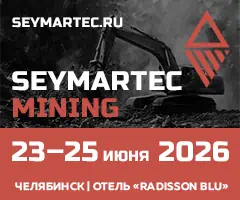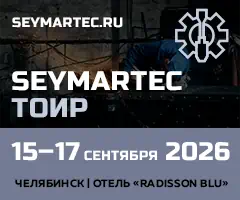Assessment of the stress state of a rock mass using the blasting and vibroacoustic methods
 V.N. Tyupin1, K.B. Ponomarenko1, 2
V.N. Tyupin1, K.B. Ponomarenko1, 2
1 Belgorod State University, Belgorod, Russian Federation
2 JSC VIOGEM, Belgorod, Russian Federation
Russian Mining Industry №6 / 2024 p. 34-40
Abstract: In order to ensure safety at the level of -250 m in the Gubkin mine of KMAruda, the following activities were performed: assessment of the rock mass susceptibility to rock bumps using the vibroacoustic method, as well as determination of the stress state of the rock mass with the blasting method. As the result of experimental studies using the vibroacoustic method, a decrease of the stress state of the rock mass was found to vary from 17.5–92.5 MPa (at the entry contour) to 10–30 MPa at the distance of 1.8 m from the wall. The blasting method used at the level of –250 m of the Gubkin mine revealed that the stress state of the rock mass at the bottoms of the cutting and auxiliary holes is 21.9–33.5 MPa, while at the bottoms of the outer and trimming holes it varies within 55.7–65.1 MPa. The blasting and vibroacoustic methods for determining the stress state of the rock mass are similar in the physics of the process. When exposed to the detonation products or the drilling tools combined with the static rock pressure, a certain volume of rock mass is destroyed. The greater the static rock pressure, the greater the volume of destruction is under the same dynamic loads. Taking into account an increase of the stress state from the center towards the outline for the rock face plane, a numerical assessment of the stress state at the entry contour after blasting of the cutting, auxiliary and outer holes was carried out based on a theoretical formula. The calculations using the formula and based on the test data coincide, which indicates creation of residual stresses within the rock mass due to the sequential detonation of the explosive sets in the blast holes.
Keywords: rock mass, physical and mechanical properties of rocks, stress state of the rock mass, blasting method, vibroacoustic method, residual stresses due to blasts
Acknowledgments: The authors express their gratitude to Malyukin Y.V. and the staff of the Geological Service of the Gubkin Mine of the KMAruda Integrated Works for support and assistance during the experimental work. We would also like to express our sincere gratitude to the staff of OOO “INGEO” including Pogorelov Yu.S., Taletsky Yu.V. and Adigamov B.Ya. for many years of fruitful cooperation, provision of equipment and assistance in discussing the results of the study.
For citation: Tyupin V.N., Ponomarenko K.B. Assessment of the stress state of a rock mass using the blasting and vibroacoustic methods. Russian Mining Industry. 2024;(6):34–40. (In Russ.) https://doi.org/10.30686/1609-9192-2024-6-34-40
Article info
Received: 23.10.2024
Revised: 21.11.2024
Accepted: 02.12.2024
Information about the authors
Vladimir N. Tyupin – Dr. Sci. (Eng.), Professor, Belgorod State University, Belgorod, Russian Federation; https://orcid.org/0000-0002-3709-0957, e-mail: This email address is being protected from spambots. You need JavaScript enabled to view it.
Konstantin B. Ponomarenko – Junior Researcher, JSC VIOGEM, Laboratory of Rock Pressure and Rock Displacement, Belgorod, Russian Federation; https://orcid.org/0000-0003-1745-9670, e-mail: This email address is being protected from spambots. You need JavaScript enabled to view it.
References
1. Влох Н.П., Сашурин А.Д. Измерение напряжений в массиве крепких горных пород. М.: Недра; 1970. 120 с. Режим доступа: https://www.geokniga.org/books/20897 (дата обращения: 28.10.2024).
2. Шкуратник В.Л., Николенко П.В. Методы определения напряженно-деформированного состояния массива горных пород. М.: Изд-во МГГУ; 2012. 112 с.
3. Сергеев С.В., Синица И.В. Геомеханическое сопровождение подземной отработки железных руд на комбинате «КМАруда». Горный журнал. 2019;(8):30–33. https://doi.org/10.17580/gzh.2019.08.05 Sergeev S.V., Sinitsa I.V. Geomechanical supervision of underground mining at Kombinat KMAruda. Gornyi Zhurnal. 2019;(8):30–33. (In Russ.) https://doi.org/10.17580/gzh.2019.08.05
4. Сергеев С.В., Синица И.В., Карякин В.Ф. Оценка склонности массива пород на КМА к горным ударам. Научные ведомости Белгородского государственного университета. Серия: Естественные науки. 2015;(9):132–137. Sergeev S.V., Sinitsa I.V., Karyakin V.F. Assessment of rock mass addiction to KMA to rock bursts. Nauchnye Vedomosti Belgorodskogo Gosudarstvennogo Universiteta. Seriya: Estestvennye Nauki. 2015;(9):132–137. (In Russ.)
5. Макаров А.Б. Практическая геомеханика. Пособие для горных инженеров. М.: Горная книга; 2006. 391 c. Режим доступа: https://www.geokniga.org/books/36123 (дата обращения: 28.10.2024).
6. Романов В.В. Инженерная сейсморазведка. М.: EAGE Геомодель; 2015. 278 с.
7. Вознесенский А.С., Демчишин Ю.В. Закономерности акустической эмиссии при деформировании горных пород. Горный информационно-аналитический бюллетень. 1999;(6):136–137. Voznesenskii A.S., Demchishin Yu.V. Regularities of acoustic emission during deformation of rocks. Mining Informational and Analytical Bulletin. 1999;(6):136–137. (In Russ.)
8. Рубан А.Д., Бауков Ю.Н., Шкуратник В.Л. Горная геофизика. Электрометрические методы геоконтроля. Ч. 3. Высокочастотные электромагнитные методы. М.: МГГУ; 2002. 148 с.
9. Казикаев Д.М. Геомеханические процессы при совместной и повторной разработке руд. М.: Недра; 1981. 288 с.
10. Тюпин В.Н., Рубашкина Т.И. Взрывные методы определения напряженного состояния массивов горных пород. Физико-технические проблемы разработки полезных ископаемых. 2018;(4):44–45. https://doi.org/10.15372/FTPRPI20180406 Tyupin V.N., Rubashkina T.I. Blasting methods of stress state determination in rock mass. Journal of Mining Science. 2018;54(4):569–574. https://doi.org/10.1134/S1062739118044026
11. Тюпин В.Н., Пономаренко К.Б. Разработка метода определения напряженного состояния горного массива при взрывной проходке выработок. Горный информационно-аналитический бюллетень. 2022;(8):27–37. https://doi.org/10.25018/0236_1493_2022_8_0_27 Tyupin V.N., Ponomarenko K.B. Method to determine rock mass stresses in mining with blasting. Mining Informational and Analytical Bulletin. 2022;(8):27–37. (In Russ.) https://doi.org/10.25018/0236_1493_2022_8_0_27
12. Тюпин В.Н., Пономаренко К.Б. Оценка достоверности взрывного метода определения напряженного состояния горного массива. Взрывное дело. 2022;(137-94):138–152. Tyupin V.N., Ponomarenko K.B. Assessment of the reliability of the explosive method for determining the stress state of a mountain range. Explosion Technology. 2022;(137-94):138–152. (In Russ.)
13. Shadabfar M., Gokdemir C., Zhou M., Kordestani H., Muho E.V. Estimation of damage induced by single-hole rock blasting: A review on analytical, numerical, and experimental solutions. Energies. 2021;14(1):29. https://doi.org/10.3390/en14010029
14. Xu J., Xue H., Rui G. Theoretical analysis of rock blasting damage in construction of tunnels closely under-passing sewage box culverts. Applied Sciences. 2022;12(19):9875. https://doi.org/10.3390/app12199875
15. Mousavi S.A., Ahangari K., Goshtasbi K. Impact of the layering of blast-induced damage factors in the hoek–brown failure criterion on the bench damage monitoring of mines. Rudarsko-geološko-naftni zbornik (Mining-Geology-Petroleum Engineering Bulletin). 2023;38(1):93–104. https://doi.org/10.17794/rgn.2023.1.9
16. Miao S., Konicek P., Pan P., Mitri H. Numerical modelling of destress blasting – A state-of-the-art review. Journal of Sustainable Mining. 2022;21(4):278–297. https://doi.org/10.46873/2300-3960.1366
17. Wang X., Zhao W.-B., Zhou H.-Y., Liu D.-S. Analysis of the tunneling blast safety criterion based on longitudinal shocks. Shock and Vibration. 2023;2023:2393030. https://doi.org/10.1155/2023/2393030
18. Zhou H., Gao Q., Fan Y., Lu W., Wang Y., Yang Y., Leng Z. Analysis of causes of vibration differences induced by different kinds of blastholes based on the interpretation of blasting parameters: A case study in dam foundation excavation. Rock Mechanics and Rock Engineering. 2023;56(10):7237–7254. https://doi.org/10.1007/s00603-023-03457-2
19. Cai B., Hao J., Peng Yu. Influence of blasting at tunnel face on an existing adjacent tunnel with oblique cross angle and small clear spacing. Journal of Engineering Science and Technology Review. 2022;15(2):177–183. https://doi.org/10.25103/jestr.152.20
20. Wang H., Zhao Y., Shan R., Tong X., Liu D. Analysis of blasting vibration effect of railway tunnel and determination of reasonable burial depth. Geofluids. 2022;2022:7151294. https://doi.org/10.1155/2022/7151294
21. Тюпин В.Н., Пономаренко К.Б. Способ определения напряженного состояния массива горных пород. Патент 2768768, Российская Федерация, заявл. 02.06.2021; опубл. 24.03.2022.
22. Влох Н.П. Управление горным давлением на подземных рудниках. М.: Недра; 1994. 208 с. Режим доступа https://www.geokniga.org/books/8924 (дата обращения: 28.10.2024).
23. Влох Н.П., Сашурин А.Д. Управление горным давлением на железных рудниках. М.: Недра; 1974. 184 с.
24. Резниченко Ю.В. и др. Сейсмоакустические методы изучения напряженного состояния горных пород на образцах и в массиве. Труды Геофизического института академии наук СССР. 1956;(34). Reznichenko Yu.V. et al. Seismoacoustic methods of studying the stress state of rocks using samples and within the rock mass. Trudy Geofizicheskogo Instituta Akademii Nauk SSSR. 1956;(34). (In Russ.)
25. Ривкин И.Д., Запольский П.А., Богданов П.А. Звукометрический метод наблюдения проявлений горного давления на шахтах Криворожского бассейна. М.: Металлургиздат; 1956. 188 c.
26. Мусин А.И., Бакаев М.Т., Овсянников П.Н. Применение микросейсмического метода для исследования массива горных пород. М.: Госгортехиздат; 1962. 64 с.
27. Тюпин В.Н. Механизм формирования зоны остаточных напряжений при взрывании в трещиноватом гранитном массиве рудников ПАО «ППГХО». Горный журнал. 2020;(10):60–64. https://doi.org/10.17580/gzh.2020.10.04 Tyupin V.N. Initiation of residual stress zone during blasting in jointed granite rock mass in operation of Priargunsky Industrial Mining and Chemical Union. Gornyi Zhurnal. 2020;(10):60–64. (In Russ.) https://doi.org/10.17580/gzh.2020.10.04
28. Тюпин В.Н. Изменение напряженно-деформированного состояния призабойного массива горных пород после взрывания проходческих шпуров. Горный журнал. 2023;(12):10–14. https://doi.org/10.17580/gzh.2023.12.02 Tyupin V.N. Change in the stress–strain behavior of rock mass after heading-aimed blasting. Gornyi Zhurnal. 2023;(12):10–14. (In Russ.) https://doi.org/10.17580/gzh.2023.12.02




